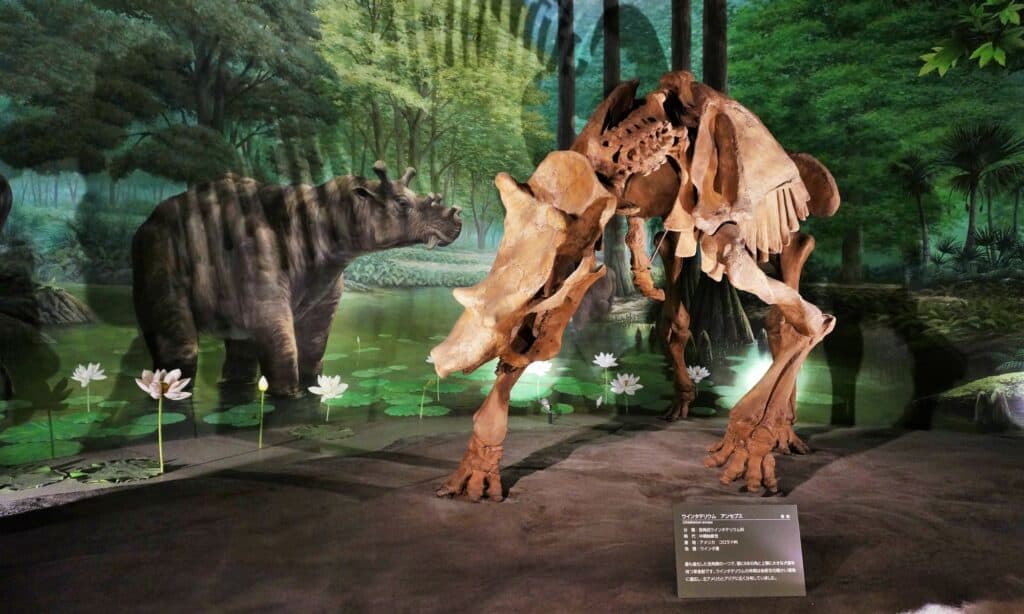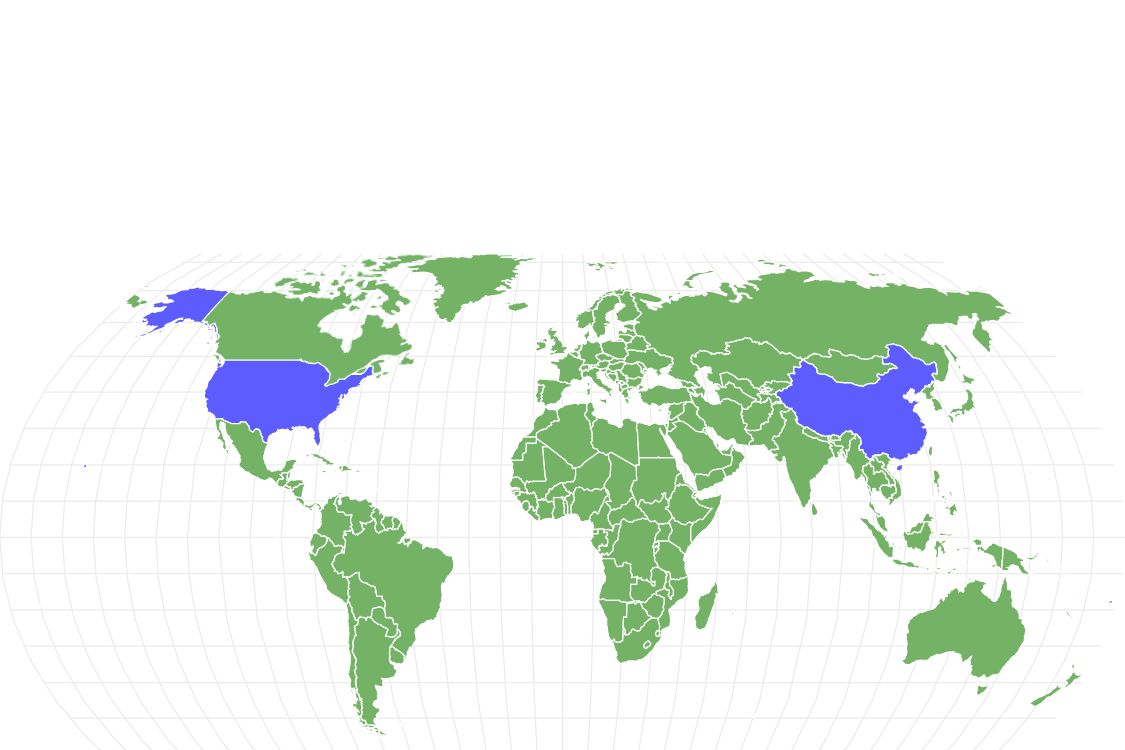Uintatherium
.jumbotron {
background-image: url(“https://a-z-animals.com/media/2022/05/Uintatherium-in-museum-400×300.jpg”);
}
}
@media only screen and (min-width: 641px) and (max-width: 920px) {
.jumbotron {
background-image: url(“https://a-z-animals.com/media/2022/05/Uintatherium-in-museum-470×370.jpg”);
}
}
@media only screen and (min-width: 921px) {
.jumbotron {
background-image: url(“https://a-z-animals.com/media/2022/05/Uintatherium-in-museum.jpg”);
}
}
Uintatherium
The Uintatherium was an exceptionally large and exceptionally ugly ungulate that lived during the Eocene epoch
Uintatherium Facts
Uintatherium Physical Characteristics
This post may contain affiliate links to our partners like Chewy, Amazon, and others. Purchasing through these helps us further the A-Z Animals mission to educate about the world’s species..

Spiders that fly! Fish that walk! And 1000+ more incredible animals. Discover them all for FREE
.photo-gallery {
–margin: 0px auto 0px;
–padding: 0px 0px 0px 0px;
}
.gallery-link {
background-image: url(“https://a-z-animals.com/media/2022/05/Uintatherium-in-museum-1024×614.jpg”);
background-repeat: no-repeat;
background-size: cover;
background-position: center;
height: 500px;
justify-content: center;
text-align: center;
align-items: center;
display: flex;
border: 2px solid #000;
}
.gallery-link img {
height: 50%;
}
@media only screen and (max-width: 768px) {
.gallery-link {
height: 300px !important;
}
}
View all of the Uintatherium images!
Uintatherium Description & Size
The Uintatherium was an exceptionally large and exceptionally ugly ungulate that lived during the Eocene epoch, which was between 56 and 34 million years ago.
It stood around 5.6 feet high at the shoulder, was 13 feet long, and weighed over 4,000 pounds or over 2 tons. It had sturdy legs to support its weight and a robust body much like that of a modern rhinoceros. However, one of the differences between the Uintatherium and the modern rhinoceros is the skull. The skull of Uintatherium was huge and was both flat in places and dipped inward in others, something rarely seen in a mammal. The bones of the skull were thick, so thick that there was not much space left for its brain. Despite the size of the creature’s skull, it was lighter than it looked because of a number of openings, or sinuses.
The Uintatherium also had large canine teeth in its upper jaw. These were bigger in males than females and probably used for defense, as the animal was an herbivore. Like modern giraffes, males had ossicones that sprouted from their skulls, though the Uintatherium had six as opposed to the giraffe’s two. Ossicones are different from the horns of rhinos in that they are bony structures covered with skin. The horns of rhinos are made of keratin, a substance that makes up fingernails.
Though it’s tempting to assume that Uintatherium is related to the rhinoceros, it probably wasn’t. Scientists are still trying to figure out just which living animal the beast is closely related to.
Origin of Its Name
Uintatherium means “beast of the Uinta Mountains.” The Uinta Mountains are part of the Rocky Mountains. They are near where the first fossils of the animal were discovered and cover an area in northeast Utah and part of southern Wyoming. Therium comes from the Greek words for “beast” or “wild animal” which are thēríon or thḗr.
Diet – What Did the Uintatherium Eat?
Like modern rhinos, the Uintatherium was an herbivore and seemed to have specialized in aquatic plants. Its long canine teeth may have helped it pull these plants out of the water. The teeth may also have been helpful in tearing out plants by their roots.
Habitat – When and Where It Lived
The uintatheriums are interesting because the two species lived in two different areas of the world at two different times. The genus was extant pretty much throughout the Eocene epoch, but U. anceps lived in the United States during the early and middle part of the epoch while U. insperatus lived in China from the middle to late part of the epoch. Fossils have been found in Utah, California, Texas, and Wyoming, and in China’s Henan Province.
Judging by its teeth, which are usually key to what an animal eats, Uintatherium probably lived in wetlands where it could eat soft aquatic plants. Save those canines, its teeth were small and not really equipped to process plants with tough stems.

Stray Toki/Shutterstock.com
Threats And Predators
As with modern rhinos, it was probably unadvisable for even an apex predator to take on a grown Uintatherium. If the animal ran in herds like elephants, predation was even more unlikely. Sick, aging, and baby Uintatheriums that had been separated from their mothers may have been on the diet of some late Eocene predators such as Andrewsarchus, the largest carnivorous mammal that ever lived. But this beast lived in Mongolia and may or may not have ever come into contact with China’s U. insperatus.
Discoveries and Fossils – Where It was Found
The first Uintatherium fossils were found by W. N. Wann in Wyoming’s Bridger Basin. They were only a few bits of skull and horn, but over the next two decades, more of the animal was found. It was given a great list of names before Uintatherium was settled on, including Titanotherium, Tinoceras, Octotomus, Ditetrodon, and Uintamastix. There was in fact a bit of a “bone war” between paleontologists Edward Cope and Othniel Charles Marsh over the fossils of Uintatherium and other prehistoric creatures in the late 19th century.
The Bridger Basin was and is fairly abundant in the fossils of animals that lived during the Eocene epoch, and many fossilized Uintatherium bones have been found there. Now there are a good number of Uintatherium skeletons on display. One is at the Utah Field House of Natural History, another is at the French National Museum of Natural History, and still, another is found in Washington D.C.’s Smithsonian National Museum of Natural History.
Extinction – When Did It Die Out?
Uintatherium died out in the Bartonian age of the Eocene epoch, which was between 41 and 38 million years ago. Since humans weren’t around to cause its extinction, paleontologists believe it was simply outcompeted by other megafauna such as Megacerops.
Similar Animals to the Uintatherium
There were several animals that were similar to Uintatherium. They include:
- Megacerops – This behemoth arose in North America in the latter part of the Eocene epoch. A browser like Uintatherium was even larger. It stood 8 feet at the shoulder and could be 16 feet long and weighed 3.6 tons.
- Embolotherium – This animal also lived during the late Eocene and was found in Inner and Outer Mongolia. It had a fantastically strange, long skull that resembled a battering ram. It stood about as tall as megacerops and weighed over 2 tons. Some scientists believe that the animal’s battering ram was actually a resonator and was too fragile to be used for defense.
- Elasmotherium – Though the animals already mentioned may have resembled rhinoceros, elasmotherium actually was a rhinoceros. It arrived later than Uintatherium and was around during the late Pleistocene epoch, as recently as 39,000 years ago. It was found in China and as far west as the Caucasus Mountains. Unlike other rhinos, this animal’s legs were long enough to allow it to properly gallop.
- Arsinotherium – Arsinotherium also lived in the late Eocene and into the early Oligocene epochs, but unlike the other animals listed it lived in North Africa. It was a bit smaller than the others, standing 5.7 feet tall and with a length of about 10 feet but was notable for a pair of impossibly huge horns over its nose and two tiny knobs over its eyes.
View all 9 animals that start with U
Uintatherium FAQs (Frequently Asked Questions)
When was the Uintatherium alive?
Uintatherium was alive through much of the Eocene epoch. E. anceps, which was found in the United States, lived from 56 to 38 million years ago while U. insperatus lived in China from 48 to 34 million years ago. All in all, the animal lived for about 15 million years, which is impressive.
How big was the Uintatherium?
The Uintatherium stood about 5.6 feet high at the shoulder, was about 13 feet long, and weighed over 2 tons.
How many Uintatherium species were there?
There were two Uintatherium species that most scientists recognize. They were:
1. Uintatherium anceps
2. Uintatherium insperatus
Some scientists add U. robustum as another species.
Was the Uintatherium intelligent?
The thick walls of its skull left little space for a large brain in this animal, but it was intelligent enough to have survived for about 15 million years. This is far longer than a lot of animal species.
How do you pronounce Uintatherium?
It’s pronounced “yoo IN tah THEER ee um.”
Sources
- Wikipedia, Available here: https://en.wikipedia.org/wiki/Uintatherium
- Prehistoric Wildlife, Available here: http://www.prehistoric-wildlife.com/species/u/uintatherium.html
- ThoughtCo, Available here: https://www.thoughtco.com/uintatherium-profile-1093289
- Smithsonian, Available here: https://www.si.edu/object/nmnhpaleobiology_3381715
















